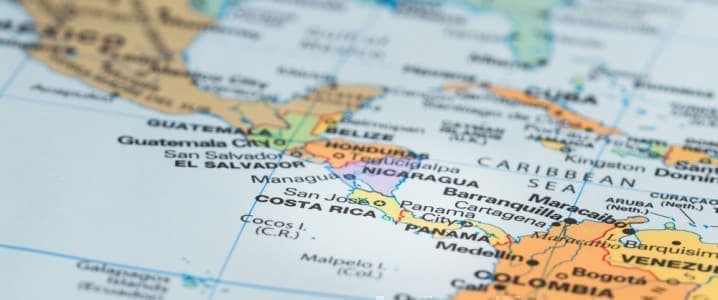A left turn? Peru’s polls closed on the 6th of June, but it took over a month for an official victor to be announced. Now, Pedro Castillo of the socialist Free Peru party has officially been elected. A confirmation of Castillo’s victory supports the idea that Latin America’s political left may be experiencing a resurgence. Castillo’s victory follows the strong result for Luis Arce of Bolivia’s Movement for Socialism party in October last year, which itself followed victories for left-leaning politicians like Mexico’s Andrés Manuel López Obrador in late 2018 and Argentina’s Alberto Fernández in late 2019.
Besides leadership elections, the overwhelming support for constitutional reform in Chile after a national plebiscite last year is also indicative of a leftward shift given associations of the current Chilean constitution with the Pinochet dictatorship. The success of independents and left-leaning parties in the elections for the Constitutional Convention and calls for greater public spending on education, healthcare, and greater state control over resources like Chile’s water supply further suggests that Chile’s plebiscite is part of this supposed trend.
Nevertheless, changes in Latin America’s political scene over the last few years have not all been favorable to the left. In Ecuador’s general election this year, the former banker and center-right politician Guillermo Lasso won against Andrés Arauz, an ally of democratic socialist and former President Rafael Correa. Among the most notable corollaries to the idea of a supposed left-wing surge was the election of right-wing populist Jair Bolsonaro in Brazil in 2019. Moreover, in 2019, Uruguay’s left-leaning Broad Front party – in government since 2005 – lost power after the electoral victory of the more conservative National Party.
Consequently, rather than being indicative of a new pink tide or conservative wave, shifts in Latin America’s political landscape are more likely indicative of frustration with the political establishment and the continued influence of trends towards populism and political polarization which have also been identified in other countries.
COVID-19 and Unrest
The onset of the COVID-19 pandemic likely played a role in stimulating voters’ decision to turn to the left and take a chance with reform. Excluding statistics for Venezuela, Latin America and the Caribbean suffered a GDP drop of almost 7% in 2020 owing to the pandemic. The loss of an estimated 26 million jobs by the end of 2020 placed further strain on people in the region and has likely played a role in stimulating protests given evidence that the deterioration of economic prospects increases individuals’ involvement in such activity. As these statistics suggest, the pandemic has also served to worsen Latin America’s already serious problem of economic inequality. At the same time as surging poverty and unemployment, the number of billionaires in the region increased.
Related: The Electricity Crisis Is A Major Problem For California's Governor However, COVID is best understood as a stimulant, rather than the root cause, of the protests and electoral shifts in Latin America over the last few years. After all, the protests which paved the way for Chile’s constitutional reform process began in 2019, before COVID emerged, and were tied to inequality and the increasing cost of living. Likewise, the protests which have rocked Colombia in recent months were started by opposition to proposed reforms that would increase taxes in various areas. COVID may have increased the public’s frustration, but the region’s unrest is founded on older, entrenched issues surrounding corruption, inequality, and a lack of opportunity.
Difficult road ahead
Regrettably, protest and political division in Latin America is likely to get worse over the medium term. This is partly because, despite signs of economic recovery and the rollout of COVID-19 vaccines, the region’s recovery from the pandemic is likely to be a slow one. The World Bank has forecast that regional per capita GDP in 2022 will be 1.5% below its pre-pandemic level. Investment into the region and growth may itself be challenged by investors’ perception of political unrest and the election of candidates like Pedro Castillo in the region.
Concerning the remaining elections this year, it is probable in Argentina that Everybody’s Front (Frente de Todos), the political coalition connected to President Fernández, will experience a setback during the country’s November legislative elections. The coalition may potentially lose its position of superiority over Together for Change, its closest rival. Support for this prediction can be found in opinion polls indicating an approval rating for President Fernández of 33.6% and public disapproval of his handling of the pandemic. There is a risk that Nicaragua’s general elections in November will result in political unrest owing to ongoing criticism of President Daniel Ortega’s actions towards the political opposition.
Related: Merger Mania Paves The Way For A New Era In U.S. Shale
Colombia’s 2022 presidential election is also an event to keep an eye on. Though presidential candidates have yet to be announced, it is probable that left-wing senator Gustavo Petro will run for election, as he did in 2018. Petro is currently among the most popular potential presidential candidates. Just as Castillo’s apparent victory in Peru has rattled some investors, a victory for Petro in Colombia would likely have a similar effect given his redistributive policy platform; it would also further cement the idea of a leftward turn in the region.
Latin America’s left-right political pendulum is ultimately indicative of the growing influence of populist politicians like Jair Bolsonaro, Pedro Castillo, and Gustavo Petro on Latin Americans increasingly desperate for change and disillusioned with political moderates. Latin America is increasingly in a position where far-reaching socioeconomic reforms are necessary to restore public confidence in democracy and institutions. Even so, the election of populists, whether from the left or right, who promise to rectify Latin America’s wrongs may further undermine democracy in the region.
By Globa Risk Insights
More Top Reads From Oilprice.com:
- Shell Reports $5.5 Billion Net Profit And Hikes Dividends
- Analysts See Oil Trading Closer To $70 Through Year-End
- Why Norway Won’t Give Up On Oil & Gas


















